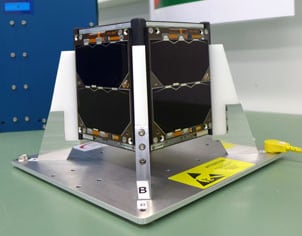In this edition:
- AMSAT Fox-Plus CubeSat Moves Toward CDR Milestone
- Hacking a Motorized RV Satellite Dish for Tracking LEO Satellites
- AMSAT Thanks 2024 President’s Club Members
- ARISS News
- Upcoming Satellite Operations
- AMSAT Ambassador Activities
- Satellite Shorts From All Over
The AMSAT News Service bulletins are a free, weekly news and information service of AMSAT, the Radio Amateur Satellite Corporation. ANS publishes news related to Amateur Radio in Space including reports on the activities of a worldwide group of Amateur Radio operators who share an active interest in designing, building, launching and communicating through analog and digital Amateur Radio satellites.
The news feed on http://www.amsat.org publishes news of Amateur Radio in Space as soon as our volunteers can post it.
Please send any amateur satellite news or reports to: ans-editor [at] amsat [dot] org.
You can sign up for free e-mail delivery of the AMSAT News Service Bulletins via the ANS List; to join this list see: https://mailman.amsat.org/postorius/lists/ans.amsat.org/
ANS-026 AMSAT News Service Weekly Bulletins
To: All RADIO AMATEURS
From: Radio Amateur Satellite Corporation
712 H Street NE, Suite 1653
Washington, DC 20002
DATE 2025 Jan 26
AMSAT Fox-Plus CubeSat Moves Toward CDR Milestone
Critical Design Review (CDR) of the new AMSAT FOX-Plus CubeSat concept is expected to occur during late May 2025 according to Mike Moore, K4MVM, AMSAT Fox Plus Systems Engineer. Launch of the newly-designed CubeSat is planned for late 2025.
Moore explained, “The purpose of the Fox-Plus Amateur Radio satellite is to continue and augment the success of the original Fox series of AMSAT 1U CubeSats. We want to have units ready to fly experimental payloads on short notice.” The term “1U” refers to the standard size CubeSat, also known as a nanosat, measuring 10x10x10 centimeters, weighing one to 1.33 kilograms.
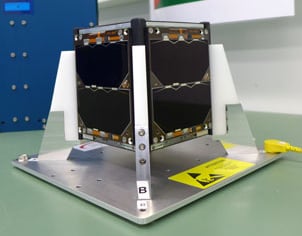
According to Moore, “To expedite the development, commercial off the shelf (COTS) components were selected. The components included the frame, electrical power system (EPS), solar panels, and antenna system (AntS) from ISISPACE.” Netherlands-based ISIS describes itself as “Disruptive Space Solutions For A Better Tomorrow” provider turn-key missions, launch services and components.
AMSAT concentrates on the Linear Transponder Module (LTM) which includes Legacy Internal Housekeeping Unit (LIHU), Improved Command Receiver (ICR) and receiver/transmitter (RX/TX) subsystem. The CubeSat Power Integrated Unit (PIU) consists of three subsystems deriving electrical energy from solar panels stored in a power battery pack (PBP).
AMSAT’s Fox-Plus A began during 2022 with a Concept of Operations (ConOps) presentation on February 11, 2022. ISIS produced components were received during 2023 then evaluated and tested during 2024. EM build and test began in the later part of 2024 and continues into 2025.
Mike Moore was first licensed in March of 2018 and earned his extra class license in November of the same year. In addition to his AMSAT work he is the ARES Emergency Coordinator for Culpeper County, Virginia and a member of the Culpeper Amateur Radio Association. He is a charter member of the Rappahannock-Rapidan Regional Emergency Communications, also known as R3EMCOMM, an all-volunteer community-wide public service organization. He uses an Icom 9700 for satellite work.
In addition to Moore, the Fox-Plus Engineering Team includes Andrew Robinson, KA3WDW (Mechanical & Structural Engineer), Cliff Jenkins, KE8JAE (Software), Will Brozovic (Software), Leandra MacLennan, AF1R (Electrical Engineer, Hardware), and Patrick Thomas, KB8DGC (System Engineer & PACSAT Liaison).
Fox CubeSat Program Background
AMSAT’s Fox CubeSat program is aligned with the U.S. National Aeronautics and Space Administration (NASA) CubeSat Launch Initiative. This provides opportunities for CubeSats built by U.S. educational institutions, and non-profit organizations to fly on upcoming launches.
Also known as the Educational Launch of Nanosatellites (ELaNa) program, NASA’s innovative technology partnerships provide CubeSat developers a low-cost pathway to conduct scientific investigations and technology demonstrations in space, thus enabling students, teachers, and faculty to obtain hands-on flight hardware design, development, and build experience.
Fox-1A (now designated AO-85) was among the earliest CubeSats launched by NASA. Fox-1 is a 1-Unit CubeSat with U/V FM repeater operating at up to 800mw along with experimental pay-loads facilitating STEM learning.
Ham Radio Now Episode 85 show host Gary Pierce, KN4AQ reveals the early days of the Fox program in his July 9, 2013 YouTube video. The show included an interview of Tony Montiero AA2TX (AMSAT VP Engineering) and Mark Hammond N4MH (AMSAT VP Education). They provided background information about the Fox-1 Satellite and talked about the AMSAT transition from purely Amateur Radio satellites to becoming a platform and communications provider for educational space science experiments.
AMSAT FoxTelem software for Windows, Mac and Linux operating systems is used to transmit satellite telemetry signals. It was developed by Christopher Thompson, G0KLA/AC2CZ/VE2TCP. Thompson also has developed other Amateur Radio Satellite software.
Payloads included a Penn State University capstone project for 2011-2012 academic year, senior engineering students. They developed a 3-axis Micro-Electro-Mechanical-System (MEMS) gyroscope to measure the spin and wobble of the satellite.
The second payload was developed by Vanderbilt University students. It recorded occurrences of radiation-induced bit upsets in modern commercial-off-the-shelf memory chips that exhibit a sensitivity to low-energy protons. The mission contributed to the validation of ground-based test methods for hardness assurance and error rate predictions.
An offshoot of the Penn State University experiment on Fox-1, Mark Spencer, WA8SME wrote about an Attitude Determination Experiment Simulator (Wobbler) in the AMSAT Journal July/August 2013 issue.
[ANS thanks Mike Moore, K4MVM, AMSAT Fox Plus Systems Engineer for the above information.]The 2025 AMSAT President’s Club coins are here now!
Celebrating the 40th Anniversary of Amateur Radio on Human Spaceflight
Help Support GOLF and Fox Plus
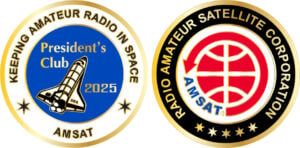
Join the AMSAT President’s Club today and help
Keep Amateur Radio in Space!
https://www.amsat.org/join-the-amsat-presidents-club/
Hacking a Motorized RV Satellite Dish for Tracking LEO Satellites
Over on the SaveItForParts YouTube channel, Gabe Emerson, KL1FI, has uploaded a new video showing how he’s hacking an old motorized Winegard RV satellite dish for tracking low earth orbit satellites, such as the NOAA and Meteor weather satellites as well as the US Military’s DMSP system.
The motorized RV satellite dish was originally intended for tracking TV satellites, but by connecting to the serial port on the control unit, Gabe is able to control the satellite dish through his own code.
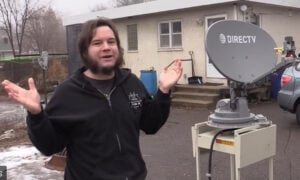
Gabe reports, “In this video I’m creating a motorized satellite tracker for S-Band signals. S-Band includes NOAA weather satellites and the US Military’s DMSP system (it’s also the radio band for WiFi, which I might look at later).
“I’m using a Winegard brand “Trav’ler” antenna designed for use on campers and recreational vehicles. It has a built-in three-axis motor system for pointing at TV satellites, but I wanted to use it for tracking satellites closer to earth. Since a low-orbit satellite like NOAA 18 or DMSP passes overhead in about 10 minutes, I need to move the dish faster and more precisely then it was intended for.
“This project is still ongoing, and I don’t yet have the code up on Github. When I do, it will be available at https://github.com/saveitforparts/ alongside the code for some similar antennas I’ve hacked in the past.
“The serial cable I’m using is described here: https://saveitforparts.wordpress.com/2023/12/29/another-portable-radio-telescope/.”
[ANS thanks rtl-sdr.com for the above information.]AMSAT Thanks 2024 President’s Club Members
Now that the books are being closed for the 2024 calendar year, AMSAT would like to extend its deepest thanks to those individuals and organizations for their extraordinary gifts to AMSAT during the past year. The President’s Club recognizes these generous donors, who together, have provided over $45,000 during 2024. The AMSAT Officers and Board of Directors thank the following:
Titanium Level ($4,800+)
Barry Baines, WD4ASW
Alan Biddle, WA4SCA
William Brown, K9LF
Platinum Level ($2,400+)
Ray Crafton, KN2K
M2 Antenna Systems
Quarter Century Wireless Association
Gold Level ($1,200+)
Anonymous
Anonymous
Burns Fisher, WB1FJ
Mark Hammond, N8MH
John Kludt, K7SYS
Glenn Miller, AA5PK
Michael Stipick, KC4RI
Silver Level ($600+)
John Boehme, K4PRK
Donald Coker, KM6TRZ
Richard Dittmer, KB7SAT
Warren Fugate, W3WE
Mark Johns, K0JM
Joseph, Lynch,N6CL
Bruce Paige, KK5DO
Peter Prendergast, W2PP
Jason Schwarz, N4JJS
Jim Tittsler, 7J1AJH
Bronze Level ($300+)
Keith Baker, KB1SF
George Gallis, AL7BX
Edward Krome, K9EK
Donald Lum, WA6ICW
Donald Pettigrew, K9ECT
Barbara Simpson, KA5CFB
Dave Taylor, W8AAS
Ronald Verweerdt, ZS6RVC
David Vine, WA1EAW
Core Level ($120+)
Oscar Alonzo, N6PAZ
Anonymous
Alan Arrison
David Batzle, N2VDY
Robert Beatty, WB4SON
Alan Boggs, K7IIV
Carlos Cardon, W7QL
James Gallagher III, KB3SQS
George Gallis, AL7BX
David Hartrum, WA3YDZ
Steven Husey, KB1UOJ
Brian Lopeman, KI7WXP
Doug Papay, K8DP
William Pesci, N4WLP
Carlos Picoto, AD7NP
Tim Pierce, N9PN
Larry Schroeder, KD4HSL
Martin Shinko, KB3AEV
Paul Stoetzer, N8HM
Owen Trott, KF5BLK
Stefan Wagener, VE4SW
Wayne Wagner, AG1A
Frank Karnauskas, N1UW, AMSAT VP-Development comments, “AMSAT receives contributions of all sizes from members and other supporters who appreciate the work that AMSAT is doing to keep Amateur Radio in Space. Every donation, big or small, is essential to AMSAT’s success. But, it is this group of donors, representing only 1.3% of AMSAT membership, that do the heavy lifting for AMSAT fund raising.
“Donations of whatever amount that makes sense for each member is especially important for 2025. After years of design work by AMSAT’s Engineering Team, they are now buying tens-of-thousands of dollars worth of parts and beginning to build the actual Fox Plus and GOLF satellites that we will have the benefit of enjoying. If you can, please donate through the members’ portal or the AMSAT Store https://www.amsat.org/product-category/amsat-presidents-club-donations/.”
[ANS thanks AMSAT for the above information.]Need new satellite antennas?
Purchase M2 LEO-Packs from the AMSAT Store!
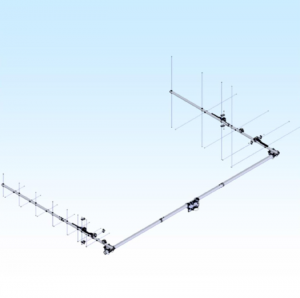
When you purchase through AMSAT, a portion of the proceeds goes towards
Keeping Amateur Radio in Space.
https://amsat.org/product-category/hardware/
ARISS NEWS
Amateurs and others around the world may listen in on contacts between amateurs operating in schools and allowing students to interact with astronauts and cosmonauts aboard the International Space Station. The downlink frequency on which to listen is 145.800 MHz worldwide.

Upcoming Contacts
Pine View School, Osprey, FL, direct via W4AC
The ISS callsign is presently scheduled to be NA1SS.
The scheduled crewmember is Sunita Williams, KD5PLB.
The ARISS mentor is Phillip Shreves, N7GZT.
Contact is go for Tuesday, January 28, 2025 at 17:21 UTC.
Watch for Livestream at:
https://www.youtube.com/@SarasotaSchools
https://www.facebook.com/sarasotaschools (Possibly)
Kyoto Municipal Shimogamo Junior High School, Kyoto-city, Japan direct via JL3ZPU
The ISS callsign is presently scheduled to be OR4ISS.
The scheduled crewmember is Nick Hague, KG5TMV.
The ARISS mentor is Satoshi Yasuda, 7M3TJZ.
Contact is go for Friday, January 31, 2025 at 09:09 UTC.
Aznakaevsky district of the Republic of Tatarstan, Russia, direct via TBD
The ISS callsign is presently scheduled to be RS0ISS.
The scheduled crewmember is Ivan Vagner.
The ARISS mentor is A.R.C. “ENERGIA, RV3DR.
Contact is go for Saturday, February,1 2025 at 11:15 UTC.
The crossband repeater continues to be active (145.990 MHz up {PL 67} & 437.800 MHz down). If any crewmember is so inclined, all they have to do is pick up the microphone, raise the volume up, and talk on the crossband repeater. So give a listen, you just never know.
The packet system is also active (145.825 MHz up & down).
As always, if there is an EVA, a docking, or an undocking; the ARISS radios are turned off as part of the safety protocol.
Note, all times are approximate. It is recommended that you do your own orbital prediction or start listening about 10 minutes before the listed time.
The latest information on the operation mode can be found at https://www.ariss.org/current-status-of-iss-stations.html
The latest list of frequencies in use can be found at https://www.ariss.org/contact-the-iss.html
[ANS thanks Charlie Sufana, AJ9N, one of the ARISS operation team mentors for the above information.]AMSAT Remove Before Flight Key Tags Now Available
Yes, These are the Real Thing!

Your $20 Donation Goes to Help Fly a Fox-Plus Satellite
Includes First Class Postage (Sorry – U.S. Addresses Only)
Order Today at https://www.amsat.org/product/amsat-remove-before-flight-keychain/
Upcoming Satellite Operations
NA-002; January 28 – February 2, 2025
VP5, Caicos Islands: Tony, KD8RTT, pays Providenciales Island a visit from Jan. 28 until Feb. 2. QRV as VP5/KD8RTT with a focus on satellites. QSL via his home callsign. (Per DARC DX Newsletter)
A growing number of satellite rovers are currently engaged in sharing their grid square activations on https://hams.at. By visiting the website, you gain easy access to comprehensive information about the operators responsible for activating specific grid squares. Additionally, you have the ability to assess the match score between yourself and a particular rover for a given pass, while also being able to identify the upcoming satellite passes that are accessible from your location.
[ANS thanks Ian Parsons, K5ZM, AMSAT Rover Page Manager, and JoAnne Maenmpaa, K9JKM, for the above information.]AMSAT Ambassador Activities
AMSAT Ambassadors provide presentations, demonstrate communicating through amateur satellites, and host information tables at club meetings, hamfests, conventions, maker faires, and other events.
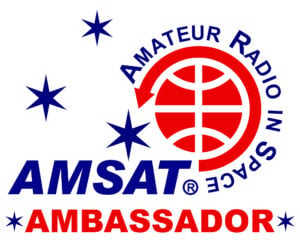
Saturday February 1, 2025 (rescheduled from January 11, 2025)
Gwinnett Amateur Radio Society – TechFest
Gwinnett County Fairgrounds
Expo Center Building
2405 Sugarloaf Pkwy.
Lawrenceville, GA 30045
K4RGK
Friday, Saturday, Sunday February 7-9, 2025
Hamcation 2025 and ARRL Southeastern Division Convention
Central Florida Fairgrounds and Expo Park
4603 W. Colonial Dr.
Orlando, FL 32808
https://www.hamcation.com/
KE4AL
February 14-15, 2025
Yuma HAMCON and Southwestern Division Convention
Yuma County Fairgrounds
Yuma, AZ
https://www.yumahamfest.com/
N1UW
April 4 – 5, 2025
Southeastern VHF Conference 2025
Quality Inn
3095 Wilma Rudolph Blvd
Clarksville, TN 37040
W4FCL
Interested in becoming an AMSAT Ambassador? AMSAT Ambassadors provide presentations, demonstrate communicating through amateur satellites, and host information tables at club meetings, hamfests, conventions, maker faires, and other events.
For more information go to: https://www.amsat.org/ambassador/
[ANS thanks Bo Lowrey, W4FCL, Director – AMSAT Ambassador Program for the above information.]Satellite Shorts From All Over
- HamSCI has announced Personal Space Weather Station sessions via zoom. The Personal Space Weather Station (PSWS) network is a distributed series of receivers designed to measure the space environment. These stations are built by professionals, citizen scientists, and ham radio operators. HamSCI and its partners are constantly at work on expanding the network, improving the PSWS data collection hardware and software, growing the network infrastructure for data storage and retrieval, as well as meeting HamSCI’s ultimate goal, analysis of the collected data. HamSCI has announced a recurring series of Zoom based sessions to help those interested in the project. Sessions occur each Thursday at 10:00 AM Eastern. More information is available on the HamSCI website https://hamsci.org/get-involved. [ANS thanks hamweekly.com for the above information.]
- The High-frequency Active Auroral Research Program (HAARP) will be conducting a research campaign January 27-31 UTC, with operating times specified in the table below. Operating frequencies will vary, but all HAARP transmissions will be between 2.75 MHz and 10 MHz. Actual transmit days and times are highly variable based on real-time ionospheric and/or geomagnetic conditions. All information is subject to change. Research topics for this campaign include VLF generation and ducting, studies on STEVE airglow, and space debris detection. This campaign will also support the GIRAFF rocket launch from Poker Flat Research Range, which is investigating the mechanisms that cause flickering and pulsing within the aurora. Note that a number of experiments will be conducted based on the critical frequency (f0F2) determined by the Gakona ionosonde. The included transmission notice supplement contains information on the frequencies HAARP is authorized to transmit. HAARP transmissions will only occur on our authorized frequencies. More information is available at https://tinyurl.com/ANS-026-HAARP. [ANS thanks hamweekly.com for the above information.]
- Electric propulsion is being increasingly used on space missions and could ultimately replace thrusters using chemical rockets. Spacecraft powered by electric propulsion could soon be better protected against their own exhaust, thanks to new supercomputer simulations. Electric propulsion is a more efficient alternative to traditional chemical rockets, and there are even plans to use electric propulsion on NASA’s Lunar Gateway space station. The idea behind electric propulsion is that an electric current ionizes (i.e. removes an electron from) atoms of a neutral gas, such as xenon or krypton, stored on board a spacecraft. The ionization process produces a cloud of ions and electrons. Then a principle called the Hall effect generates an electric field that accelerates the ions and electrons and channels them into a characteristically blue plume that emerges from the spacecraft at over 37,000 mph (60,000 kph). Hence an electric propulsion system is also referred to as an ion engine. More information at https://tinyurl.com/ANS-026-ION. [ANS thanks space.com for the above information.]
In addition to regular membership, AMSAT offers membership to:
- Societies (a recognized group, clubs or organization).
- Primary and secondary school students are eligible for membership at one-half the standard yearly rate.
- Post-secondary school students enrolled in at least half time status shall be eligible for the student rate for a maximum of 6 post-secondary years in this status.
- Memberships are available for annual and lifetime terms.
Contact info [at] amsat [dot] org for additional membership information.
73 and remember to help Keep Amateur Radio in Space!
This week’s ANS Editor, Frank Karnauskas, N1UW
f.karnauskas [at] amsat [dot] org
 Organisasi Amatir Radio Indonesia Daerah Sulawesi Barat
Organisasi Amatir Radio Indonesia Daerah Sulawesi Barat
